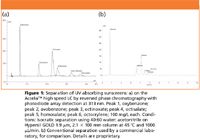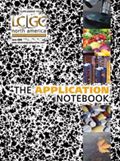Determination of UV Absorbers from Sunscreens by UHPLC with Photodiode Array Detection
Measure UV-absorbing compounds in consumer products and characterize the UV absorption spectra of the individual components by employing high-speed liquid chromatography with photodiode array detection.
Measure UV-absorbing compounds in consumer products and characterize the UV absorption spectra of the individual components by employing high-speed liquid chromatography with photodiode array detection.
Sunscreens are topical lotions that disperse UV absorbing compounds in an oily base that may also contain emollients, skin moisturizers, and light reflecting particles of zinc oxide. Common UV-absorbers added to sunscreens include oxybenzone (benzophenone), avobenzone, octinoxate (octyl methoxycinnamate), octisalate (octylsalicylate), homosalate, and octocrylene.
The oily matrix of sunscreen lotions coupled with the high UV absorbance of the analytes makes HPLC the method of choice for analysis of sunscreens, and by using photodiode array detection, the complete absorption spectrum of each compound is obtained as it elutes. The sensitivity of HPLC/PDA is also sufficient to measure these compounds in environmental water samples, which facilitates research on exposure and environmental fate. In this application, an HPLC method used by a commercial analytical laboratory is improved by using ultra high performance liquid chromatography (UHPLC) on a Hypersil GOLD 1.9-μm column. The resolution of adjacent peaks is improved even as method run time is reduced from 45 to 7 min. Applications include determination of UV absorbers in three consumer products and in water from a public swimming pool. Also documented is chromatographic method performance including resolution, calibration range, method detection limits, and precision of retention time and peak area.
Experimental Conditions
Samples
Samples of three commercially available sunscreens were prepared for UHPLC analysis and a sample of swimming pool water was collected from a local public pool and prepared by using solid phase extraction. The sample was reconstituted in 200 μL of mobile phase, filtered into an autosampler vial, and injected.
Instrumentation
Thermo Scientific Accela High-Speed Liquid Chromatography system with PDA Detector Thermo Scientific ChromQuest 5.0 Chromatography Data System (CDS).
Chromatographic conditions
Columns: Thermo Scientific Hypersil GOLD, 1.9 μm, 100 × 2.1 mm (Thermo Scientific 25002-102130)
Mobile phase: A: Water
B: Acetonitrile
Isocratic: 40:60
Flow rate: 1000 μL/min
Run time: 7 min
Detector: PDA, D2, and W lamps, 10-mm flow cell, 20Hz, 0s rise time
Scans: 200-500 nm, 1Hz, 1nm bandwidth, Step1
Discrete: 313 nm, 20Hz, 11nm bandwidth
Column temp.: 45 °C
Injection: 1 μL "no waste" injection from 25 μL sample loop, 4 μL/s 1 mL Flush and 1 mL Wash, using 90:10 acetonitrile: water from Flush Reservoir
Results
The UHPLC separation of sunscreen agents provided by this application (Figure 1) provides better resolution, peak shape, and run time compared to the original method used by the commercial laboratory. Particularly noteworthy is the 6-fold improvement in run time and sample throughput.

Figure 1
Conclusion
A fast HPLC separation performed on the Accela high speed chromatography system equipped with a PDA detector resolves six UV-absorbing components of sunscreens in about six min with retention time and peak area precision better than 1% RSD. The UV absorbance spectrum of each compound is acquired as it elutes and can be matched against a stored spectral library to aid in compound identification.

Thermo Fisher Scientific, Inc.
355 River Oaks Parkway, San Jose, CA 95134-1991
tel. (800)532-4752, fax (561)688-8731
Website: www.thermo.com

Free Poster: NDSRI Risk Assessment and Trace-Level Analysis of N-Nitrosamines
April 25th 2025With increasing concern over genotoxic nitrosamine contaminants, regulatory bodies like the FDA and EMA have introduced strict guidelines following several high-profile drug recalls. This poster showcases a case study where LGC and Waters developed a UPLC/MS/MS method for quantifying trace levels of N-nitroso-sertraline in sertraline using Waters mass spectrometry and LGC reference standards.
New TRC Facility Accelerates Innovation and Delivery
April 25th 2025We’ve expanded our capabilities with a state-of-the-art, 200,000 sq ft TRC facility in Toronto, completed in 2024 and staffed by over 100 PhD- and MSc-level scientists. This investment enables the development of more innovative compounds, a broader catalogue and custom offering, and streamlined operations for faster delivery. • Our extensive range of over 100,000 high-quality research chemicals—including APIs, metabolites, and impurities in both native and stable isotope-labelled forms—provides essential tools for uncovering molecular disease mechanisms and exploring new opportunities for therapeutic intervention.
New Guide: Characterising Impurity Standards – What Defines “Good Enough?”
April 25th 2025Impurity reference standards (IRSs) are essential for accurately identifying and quantifying impurities in pharmaceutical development and manufacturing. Yet, with limited regulatory guidance on how much characterisation is truly required for different applications, selecting the right standard can be challenging. To help, LGC has developed a new interactive multimedia guide, packed with expert insights to support your decision-making and give you greater confidence when choosing the right IRS for your specific needs.
Using the Carcinogenic Potency Categorisation Approach (CPCA) to Classify N-nitrosamine Impurities
April 25th 2025Learn how to manage nitrosamine impurities in pharmaceuticals with our free infographic. Discover how the CPCA approach establishes acceptable intake limits and guides the selection of NDSRI reference samples. Stay compliant and ensure safety with our ISO-accredited standards.

.png&w=3840&q=75)

.png&w=3840&q=75)



.png&w=3840&q=75)



.png&w=3840&q=75)














